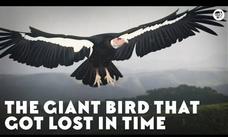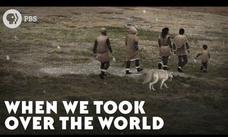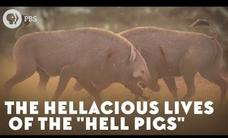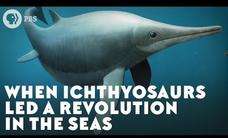Be Smart
Why Do We Cry Sad Tears?
Although some may be crocodile tears, crying is a distinct honor humans hold. Scholars learn the biological reason behind the emotional crying in a video lesson. The lesson instructor explores the anatomical and psychological connections...
PBS
The Evolution of the Heart (A Love Story)
Not all hearts are the same, but their functions are similar. An instructor discusses the origin of the first organisms with a heart in a video lesson from the PBS Eons series. The lesson includes discussion of the evolution of the...
Be Smart
Which Life Form Really Dominates Earth?
Humans only make up 0.01 percent of all life forms on Earth. We sure know how to make an impact though! An episode of the It's Okay to be Smart series examines the proportion of different species that inhabit Earth. The...
Be Smart
It's Okay to Fart (The Science of Flatulence)
Like it or not, passing gas is part of life ... almost all life! Flatulence has many different purposes in different species including communication, defense, and buoyancy. Pupils learn where farts come from and what contributes to their...
American Chemical Society
How Is Leather Made?
Leather tanning is a chemical production! Scholars watch as a video outlines the chemistry behind processing leather. The instructor describes the chemical makeup of the leather itself and the structure of the chemicals that preserve the...
American Chemical Society
Why Don’t Antarctic Fish Freeze to Death?
Some fish not only survive but thrive in Antarctic waters. Learn their secret in a lesson in an informative video about the freezing point of the salty sea water as well as the antifreeze proteins in the species' circulatory system.
PBS
The Giant Bird That Got Lost in Time
The California condor is the largest flying bird in North America and has been for a very long time. While perfectly equipped to survive in their time period, today there are fewer and fewer in existence. An episode of a larger series...
TED-Ed
How Light Technology Is Changing Medicine
Medicine has gone high tech. But how do the new, less invasive diagnostic tools work? An engaging short video sheds light on how integrated photonics is revolutionizing the medical sensor industry.
PBS
When Giant Scorpions Swarmed the Seas
Bigger and faster is not always better! Explore the characteristics of the ancestors of the current scorpions with an intriguing video. Scholars learn the connections of these changes to the environment of the different time periods.
PBS
When We Took over the World
Exactly how did humans become the top of the food chain? Follow archeologists through an analysis of the fossil records during a video presentation from the PBS Eons series. The ancient artifacts trace human evolution from Africa to the...
PBS
The Ghostly Origins of the Big Cats
A lack of fossil records forces scientists to piece together the evolution of the big cats. The PBS Eons video lesson describes the processes scientists use to infer evolutionary details and predict possible species. Scholars get an...
PBS
The Hellacious Lives of the "Hell Pigs"
Some animals have more in common than meets the eye. An episode of the PBS Eon series analyzes the fossil records of a mammal nicknamed the hell pig. The lesson describes how evolutionary methods determine the genetic evolution of the...
PBS
When the Synapsids Struck Back
As environments change so must their inhabitants, or extinction will prevail. An in-depth look at the evolution of the synapsids shows how one group overcame environmental changes and survived. The video lesson from the PBS Eon series...
PBS
When Ichthyosaurs Led a Revolution in the Seas
During The Great Dying, 90 percent of life in the ocean died. A video lesson from the PBS Eon series describes how the oceans recovered. Viewers learn how some species adapted and thrived while others became extinct.
Krista King Math
How to Write Small and Big Numbers in Scientific Notation
Now you don't have to write all those zeros. Viewers of this video learn how to write large and small numbers in scientific notation. The video covers two examples for each type.
Curated OER
How Do You Find a Missing Angle in a Triangle?
The interior angles of any and ALL triangles adds up to 180 degrees. So if given two of the angle degrees, is it possible to find the value of the third angle? Yes! Use the triangle sum theorem to solve for the missing angle. Watch this...
Physics Girl
What Do Programmers Actually Do?
So you want to be a programmer, huh? An episode from a comprehensive series about physics describes what it's like to be a software programmer. The narrator interviews actual programmers to dispel myths about the profession.
Khan Academy
Khan Academy: Subtracting Two Digit Numbers Without Regrouping (Example 2)
Sal subtracts two-digit numbers (without regrouping) by thinking about tens and ones. Includes a video, transcript, and question and answer section. [2:20]
Khan Academy
Khan Academy: Breaking Apart 3 Digit Addition Problems
Sal shows ways to break up three-digit addition problems using place value. Includes a video, transcript, and question and answer section. [3:41]
PBS
Pbs: Frontline: Digital Nation: Life on the Virtual Frontier
Presents an in-depth exploration of what it means to be human in a 21st-century digital world. Looks at the implications of living in a world consumed by technology and the impact that this constant connectivity may have on future...
Common Sense Media
Common Sense Media: Digital Footprint
Think carefully before posting and sharing! This video is all about the digital footprint we all leave behind online. [1:07]
Khan Academy
Khan Academy: Strategies for Adding 2 Digit Numbers
Watch as Sal goes through multiple strategies for adding 2-digit numbers. [3:15]
Common Sense Media
Common Sense Media: Privacy Student Intro Video: The Digital Footprint
Students learn that they have a digital footprint and that they need to think critically about what information they put online. [1:57]
Other
Moore Public Schools: #Think Twice Your Digital Footprint Matters
Moore Public Schools interviewed students, principals, counselors, university professors, admissions officers, college coaches, law officials, and more to dive into the consequences of creating a negative digital footprint. Abigail Ogle...
Other popular searches
- Digital Storytelling
- Digital Photography
- Digital Clock
- Digital Media
- Digital Imaging
- Digital Art
- Digital Microscope
- Digital Video Camera
- Digital Self Portraits
- Digital and Analog Clocks
- Netiquette
- Digital Cameras
























